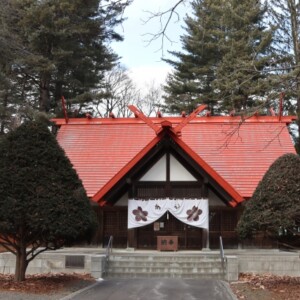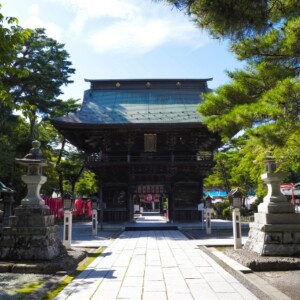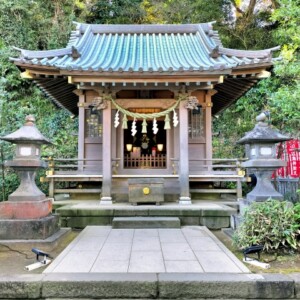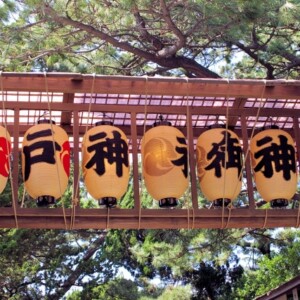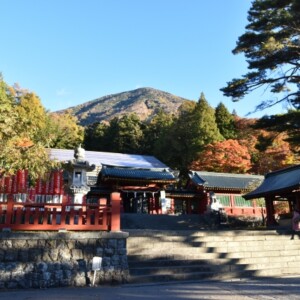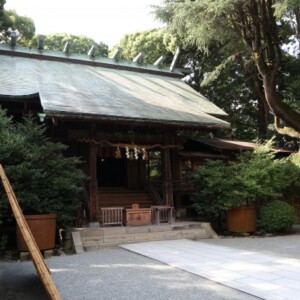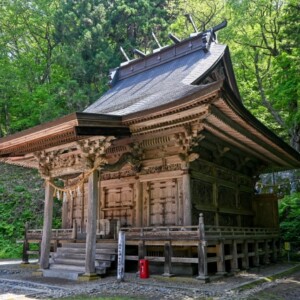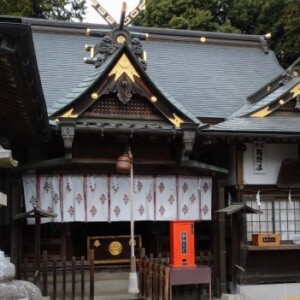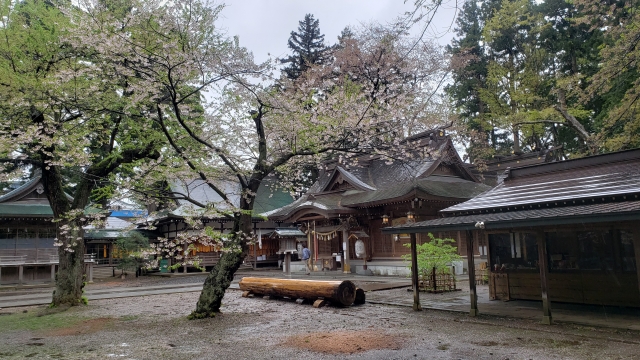
Komagata-jinja Shrine|A complete guide to the history, highlights, and worship information of this historic shrine
Rikuchu Ichinomiya Komagata Shrine, located in Mizusawa Park in Oshu City, Iwate Prefecture, is a historic shrine with a long history of 1,500 years. It has long maintained its prestigious status as the first shrine in Rikuchu (present-day Iwate Prefecture), and is revered by many as a prominent shrine that is listed in the Engishiki Shinmeicho as a shiki-uchi-sha (Shinto shrine). The shrine grounds are surrounded by 250- to 300-year-old higanzakura cherry trees, designated as a natural monument by Iwate Prefecture, and are also a popular spot for cherry blossom viewing.
Outline and basic information about Komagata Shrine, Rikuchu Ichinomiya Shrine
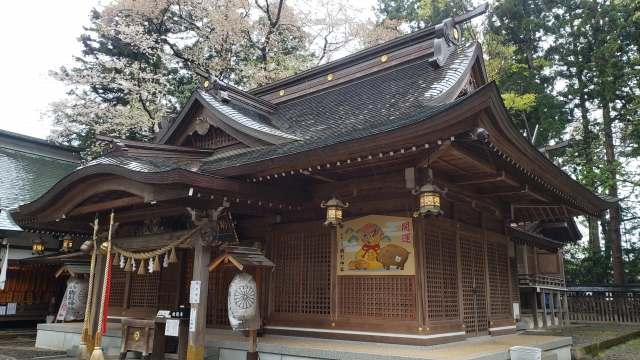
Rikuchu Ichinomiya Komagata Shrine consists of the head shrine in Mizusawa-Nakaueno-cho, Oshu City, the Okumiya Shrine on the summit of Mt. Komagatake in Nishine, Kanegasaki Town, Isawa County, and the Satomiya Shrine in Hinagosawa, Nishine, Kanegasaki Town, Isawa County, and is currently designated as a separate shrine by the Jinja Honcho. Formerly a Kokuhei-kosha, a shrine of high prestige, it has played a central role in the faith of the local community.
History and Origin
Komagata Shrine was enshrined on the summit of Komagatake in the Yakeishi mountain range about 1,500 years ago, and was moved to its present location in 1903. According to the oldest tradition, Komagata-sama was enshrined on the summit of Komagatake (now Dainichidake) in the reign of Emperor Osugi (around 456) by Lord Kamimono Isawa, a descendant of the 10th Emperor Sojin.
There is a theory that the Kamomono clan extended their power northward from the Kanto region, found mountains with dormant volcanic outer rim in various places, named them Komagatake or Komagatayama, and enshrined the deity Komagata. According to this theory, the origin of Komagata Shrine is deeply related to the northward expansion of the Kamigeno clan.
During the Heian period (794-1185), Komagata Shrine was revered by the Imperial Court, and after a bloodless battle against the Ezo Aterui, General Sakagami Tamuramaro (c. 802) proposed to the Imperial Court that Komagata Shrine, which was also the guardian deity of the Ezo, be elevated to the rank of deity. In the first year of Ninju (851), Komagata no Kami was promoted to the fifth rank, and in the fourth year of Jougan (862) to the fourth rank, which was the highest rank in Mutsu.
It is said that the shrine was revered by Minamoto no Yoriyoshi and Yoshiya and the Fujiwara clan of Hiraizumi during the Heian and Kamakura periods.
Deities and Benefits
Komagata Shrine is dedicated to six deities: Amaterasu, Amateru, Kunisatate, Agatsu, Okise, and Hikohi, collectively called “Komagata Ookami. These deities are mentioned in the 1797 munefuda of the Hinakozawa Satomiya and in the “An’ei Fudoki” compiled by the Sendai han (feudal domain).
Komagata Ookami is widely worshipped as the guardian deity of horses, and is known as a shrine that brings luck and destiny. Komagata-ojin is also known as the guardian deity of horses, and is believed to be especially beneficial for traffic safety, victory, and physical health. In modern times, the shrine also offers “Nito Gomamori,” a charm named after a major league baseball player from Oshu City, which is popular among many visitors who wish to improve their mental and physical skills and achieve their goals.
Within the precincts of the shrine are Shiogama Shrine, Yamakamisha Shrine, and Mizusawa Shokonsha Shrine, each of which is believed to bring blessings such as traffic safety, victory, and protection from the direction of the sun, making it a shrine of great spiritual power to meet a variety of wishes.
Highlights and Features of Komagata Shrine
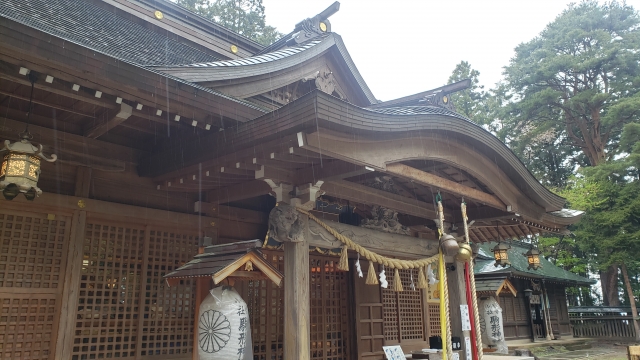
Komagata Shrine is located in the rich natural environment of Mizusawa Park, and is an attractive shrine where historical buildings and beautiful natural scenery are in harmony. As one of the most prestigious shrines in Iwate Prefecture, it has a reputation as a power spot for many people who visit the shrine to enjoy the changing scenery in spring, summer, fall, and winter.
Attractive architecture and structures
The current shrine pavilions were renovated in 2003 to commemorate the 100th anniversary of the shrine’s dedication, and the beauty of the prestigious shrine architecture has been preserved. The shrine grounds create a sacred atmosphere of serenity and tranquility, and are surrounded by old cherry and cedar trees, providing visitors with a tranquil shrine that offers peace of mind.
In addition to the head shrine, there are two other shrines: the Okumiya at the top of Mt. Komagatake and the Satomiya in Nishine-Hinagosawa, Kanegasaki Town, Isawa County, which are a valuable composition that tells the history of mountain worship. The Okumiya Shrine, in particular, has a history of being called “Matou Kannon-do” in modern times, and still carries the vestiges of the era when Shintoism and Buddhism were intermingled.
Cherry blossoms and natural beauty in the precincts
One of the most unique features of Komagata Shrine is that the shrine grounds and Mizusawa Park are famous for its higan-zakura cherry blossoms, with old trees ranging from 250 to 300 years old and designated as a natural monument by Iwate Prefecture as the “Hikan-zakura group of Komagata Shrine and Mizusawa Park.
More than 400 cherry trees, including Someiyoshino, weeping cherry, and Edohigan cherry trees, bloom from the shrine grounds to Mizusawa Park. One of the characteristics of higan cherry trees is that they bloom earlier than yamazakura and someiyoshino cherry trees, although their flowers are smaller.
In spring, the “Mizusawa Park Cherry Blossom Festival” is held from early to late April every year, and visitors can enjoy the cherry blossoms as well as the cherry blossom viewing at the Hanami Restaurant Center and other stalls. When the cherry blossoms come to an end, the park is covered with colorful azalea blossoms, offering a different view of the park.
Cultural Properties and Important Historic Sites
Komagata Shrine and its surroundings are home to many valuable cultural assets and historical sites that tell the story of its long history. Dotted throughout the park are two bronze statues of Shinpei Goto (one in his role as the first president of the Boy Scouts of Japan and the other as the first president of the South Manchuria Railway), a bronze statue of Minoru Saito, a monument to Choei Takano, a monument to Shiki Masaoka, the grave of Etsuko Matsudaira (daughter of Mitsuyuki Kuroda), a seven-story tower, and a memorial to the dead from the Boshin War, all of which give visitors a sense of the shrine’s history and local culture.
Of particular note is the landscaping of Mizusawa Park, which is said to have been created in 1878 by Minomushi Yamato, a wandering painter and landscape architect, and is a valuable cultural heritage that conveys the superior landscaping techniques of the Meiji period to the present day.
Visiting Guide
Rikuchu Ichinomiya Komagata Shrine is a sacred place visited by many worshippers as a prestigious Ichinomiya shrine. By paying attention to the proper etiquette and paying respect to the gods while visiting the shrine, you will receive deeper blessings.
Worship Etiquette and Manners
Worship at shrines is an important act of purifying the mind and paying homage to the gods. At Komagata Shrine, it is recommended that you follow the general manners of shrine visitation.
First, bow lightly as you pass through the torii gate, and walk down the approach to the shrine avoiding the center of the path. At the hand-watering place, purify your left hand, then your right, and rinse out your mouth to purify yourself before going to the hall of worship. In front of the hall of worship, pay money offering, ring the bell, and then worship in the manner of “Ni-worship, Ni-applause, Ni-tei-worship”.
Since Komagata Shrine is dedicated to the guardian god of horses and is known as a shrine that brings luck and destiny, many people visit the shrine to pray for traffic safety, goal achievement, physical health, and so on. By praying wholeheartedly in the tranquil precincts of the shrine, you will feel the blessings of Komagata-ojin.
Annual & Seasonal Events
Komagata Shrine holds a variety of Shinto rituals and events throughout the year that are popular among local residents and visitors. One of the most famous is the “Children’s Cavalry Warrior Procession” held every May, which has become a central event in this area where horses are the guardian deity. This traditional festival symbolizes the Komagata Shrine’s character as a god of horses, and is a spectacular event in which local children dress up in warrior costumes and perform a cavalry procession.
During the cherry blossom season in spring, the “Mizusawa Park Cherry Blossom Festival” is held from early to late April, and the shrine grounds and the entire area of Mizusawa Park are crowded with people viewing the cherry blossoms. During the festival, the park is filled with restaurants and stalls for cherry blossom viewing, and at night the park is lit up with paper lanterns, creating a special atmosphere for enjoying the cherry blossoms at night.
During the New Year’s holiday, many visitors come to the park for the first time to pray for good health and safety in the New Year. The mikan-maki (mandarin orange sowing) and Dondon Festival are also held, and are well-known as traditional local events.
Red Seal and Good Luck Charm Information
Komagata Shrine offers red seals to commemorate visits to the shrine. The red seal, prayer, and amulet are available from 9:30 to 16:30, and can be received at the shrine office during these hours. As the most prestigious shrine in Rikuchu, red seals are cherished by many visitors to the shrine.
The “Nito Gomamori” is a particularly popular amulet, named after a major league baseball player from Oshu City, and is a talisman for physical health and achievement of goals. It is also known as the “Shaping up (sei)” amulet, and is recommended for children, who bear the future, and for those who wish to improve their work performance.
Other charms are available for various wishes such as traffic safety, victory, and directional protection, to meet the diverse needs of visitors. Please ask at the shrine office when you visit the shrine for more detailed information about the items to be awarded.
Access/Use Information
Rikuchu Ichinomiya Komagata Shrine is conveniently accessible by both public transportation and private vehicles. Due to its location in Mizusawa Park, the shrine can be crowded during cherry blossom season and festivals, so we recommend that you allow plenty of time for your visit.
Public Transportation Access
Access by train: The temple is conveniently located about a 13-minute walk from Mizusawa Station on the JR Tohoku Honsen Line, and about a 15-minute drive from JR Mizusawa Esashi Station, which is the closest station for those using the Tohoku Shinkansen Line.
Access by car Access from the expressway is also easy, approximately 12 minutes from the Mizusawa Interchange on the Tohoku Expressway and 7 minutes from the Oshu Smart Interchange. It is convenient to enter “Mizusawa Park” or the address of the shrine in your car navigation system.
Rikuchu Ichinomiya Komagata Shrine is located at 1-83, Mizusawa Naka Ueno-machi, Oshu City, Iwate Prefecture (in Mizusawa Park).
<Address> 1-83, Mizusawa Naka-Ueno-machi, Oshu City, Iwate Prefecture, 023-0857, Japan
Hours of worship, fees, and parking information
Hours of visitation
Summer (April to October): 5:30 to 18:00, Winter (November to March): 5:30 to 17:30. The reception desk for red seals, prayers, and amulets is open from 9:30 to 16:30, so please visit the shrine during these hours if you wish to receive a red seal or amulet.
Special hours are set for the year-end and New Year’s holidays: 5:30-17:30 at the end of the year, 0:00-20:00 on New Year’s Day, and the regular opening hours from January 2 onward.
Admission Fee
There is no charge to visit the shrine. A separate fee is required for prayers.
Parking Information
Parking for 168 cars is available. 300 yen per 12 hours for regular cars, 400 yen per 12 hours for over 24 hours. 500 yen per 24 hours for large cars, 500 yen per 12 hours for over 24 hours. Crowding is expected during the Cherry Blossom Festival and other major festivals, so early arrival is recommended.
Reference sites
Rikuchu Ichinomiya Komagata Shrine Official Website: https://komagata.iwate.jp/
Rikuchu Ichinomiya Komagata Shrine (old site): http: //www.rnac.ne.jp/~komagata/



